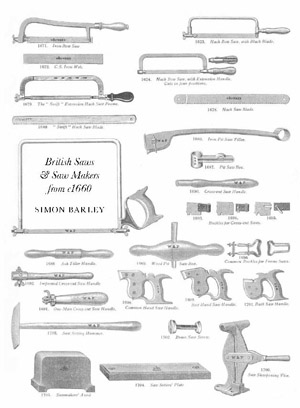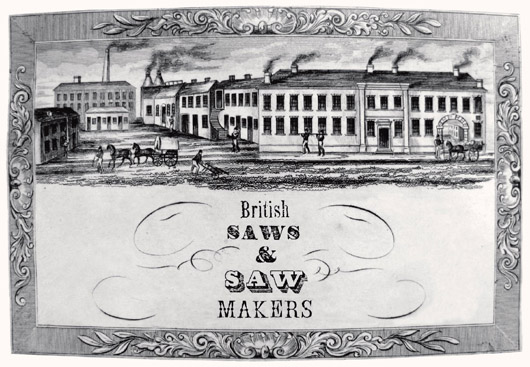Although not published by TATHS we are sure that all members will want to know more about this long-anticipated work.


My affair with English saws began a long time ago. Sometime around 1998 I met Ken Hawley at his delectable tool shop in central Sheffield, renowned as the place that announced in the window "We sell nowt [in local dialect "nothing"] but tools".
Most of what I got there was new tools, but I also acquired from him the first set of hollows and rounds that helped me to get started on using moulding planes. I was by then several years into a major project of converting a 19th century stone barn into a house, and was more and more fascinated by the wonderful tools I could use – machinery frightened me, it made a terrible noise and dust, and it did not enable me to learn the feeling of the timber as I worked it.
Released from a 9-5 job, I was looking for voluntary work, and nothing could be more attractive in that line than a day or two a week in Ken's Collection, housed then by the University of Sheffield in a small old steel warehouse. I asked what I could do there, and he at once suggested I catalogue the saws, and the saw-making tools and materials.

It soon became evident that there was little known about how saws were made in the days before automatic machinery and to come across this area of the unknown stimulated an old impulse lurking at the back of my mind to write up some research, as my job had always been too busy to give me the time.
Before long I'd signed up to write a PhD on the early saw making industry of Sheffield, and it only took me 9 years...
But while I was doing it, friends in the tool history world suggested that a reference book on saws could usefully fill a gap in the literature: this bit has taken me another 6 years...
Central to the history was also the opportunity to collect on my own behalf, and again the situation two decades ago was very different in those pre-ebay days, as British saws were not the desirable objects they have become, and a box full of rusty has-beens could easily be had for a few pounds.
I was therefore able to take advantage of what cannot be done now, and I have been able to amalgamate on one site at the Ken Hawley Collection Trust's new home in Kelham Island Museum both my own and Ken's saws, which amount to about 2000 examples.

Asked why so many, my response is always that we are a museum, and that one purpose of a museum is to have a reference collection – in other words one of everything. But in the process of collecting one saw, every collector of course picks up maybe another two or three, has the chance to discuss the salient points with friends and slowly test theories, and constantly learn from others.
I learned a huge amount from Ken, and his recent death is an almost frightening blow, as inside his head was a store of knowledge that doesn't exist anywhere else, and in spite of what I gained much from my years of conversations with him, I always knew that I hadn't heard by any means all of it.
But those who write history books can only do their best with what they know, at the same time acknowledging that what they put down on paper is incomplete and immediately out of date. I hope that there will be a core of permanence in this British Saws and Saw Makers from 1660 and that others will find it a useful base from which to build.
The essential 700 page reference book.
Colour illustrated chapters on how saws were made, the centres of saw manufacture, the way that saw designs changed, saw handle design and fixings, types of hand saw, and a directory with detailed descriptions of makers and dealers, and more than 1500 illustrations of makers’ marks.
Now available in hardback only from booksellers at UK RRP of £55, or signed copies direct from the author at £49, with free post and packing. Sadly, we are no longer able to handle sales outside Europe.
Overseas sales will have to be made in the country where the buyer lives, unless they are prepared to pay the postal charges, which from mid 2020 are now very heavy.
Contact Simon Barley at:
Tanglewood
Besbury
Minchinhampton
Stroud GL6 9EP
England
or barleys@mac.com. Payment can be taken by cheque, BACS or Paypal.
{gallery}News/2014/Barley_saws/1024{/gallery}